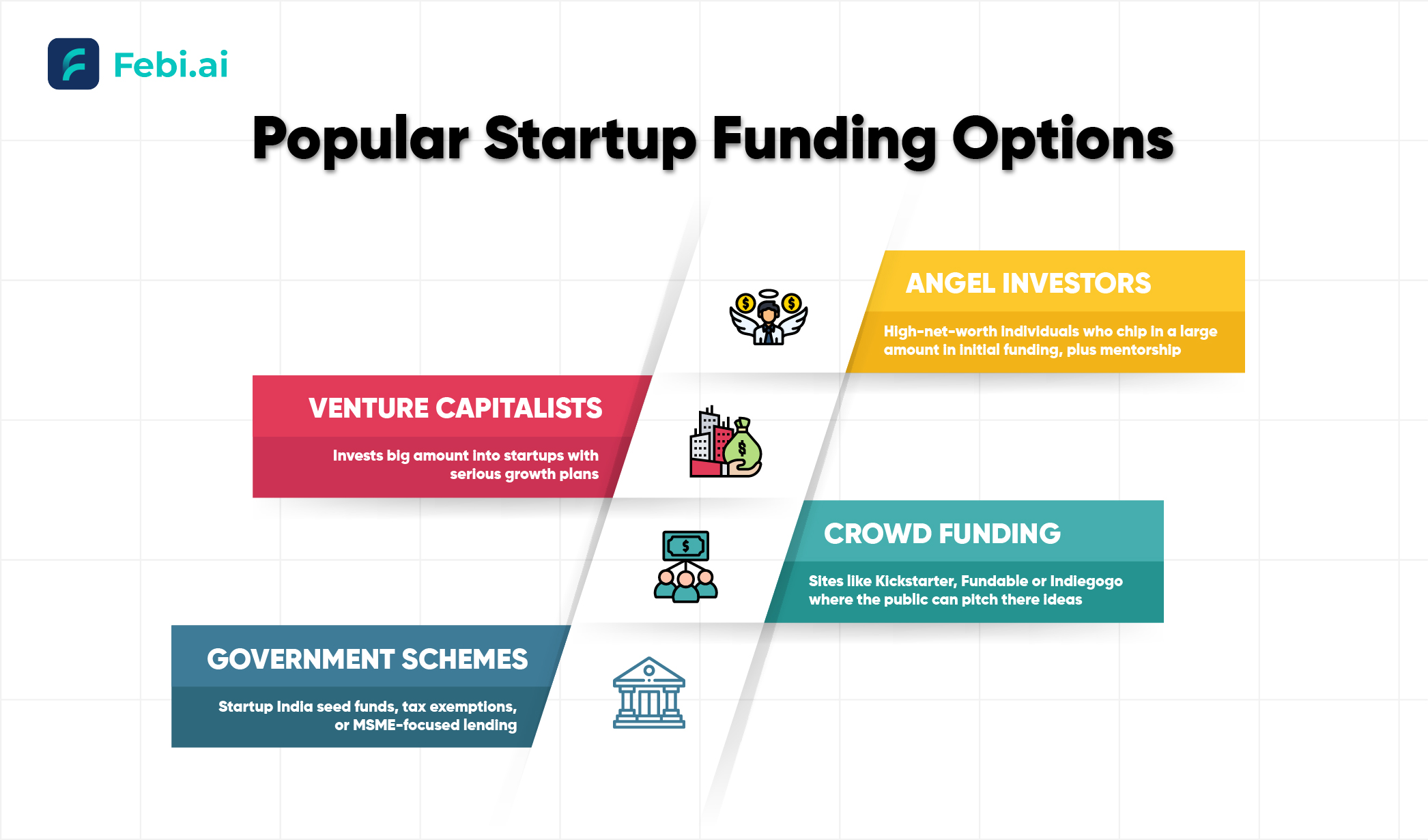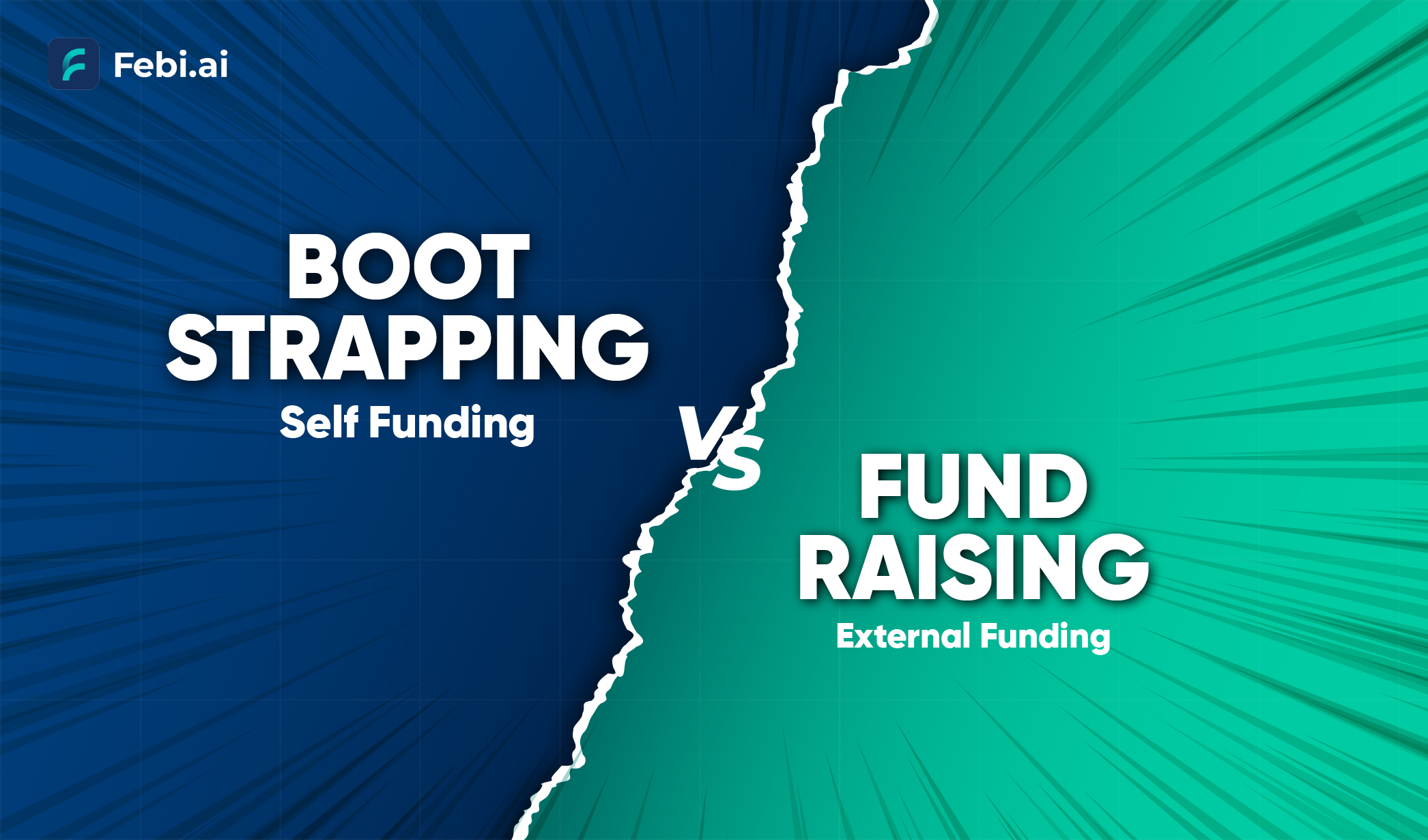Table of Contents
Starting a business? Yeah, it’s kind of like strapping into a rollercoaster blindfolded. One minute you’re buzzing with fresh ideas, and the very next moment you’re staring at your empty wallet wondering how you’ll even cover your bills. It’s messy, exciting, and occasionally terrifying. And somewhere in that chaos, a big question arises which demands an answer:
Where will that money come from?
Will you dig into your savings, grit your teeth, go all-in with bootstrapping strategies for startups? Or will you take another route: knocking on investor’s doors, and chase external startup funding options?
This isn’t just about money – it’s about how you build, grow, and survive. So, let’s unpack both paths – bootstrapping vs fundraising – with real pros, cons, and financial planning tips that could spare you a ton of time, money, and anxiety down the road.
Understanding Startup Funding Options
Two Roads, One Startup
Founders usually find themselves at a fork in the road:
- Bootstrapping (Self-funding): You bank on personal savings, early revenue, or reinvested profits. It’s lean, raw, and often scrappy.
- Fundraising (External funding): You seek capital through Angel Investors, Venture Capitals or crowd funding for business startup. It’s about trading equity or promises for a financial push.
Popular Startup Funding Options

A 2023 report from Startup Genome found that just 1 in 10 startups actually secure external capital. This stat hits hard. It also tells us that bootstrapping strategies for startups aren’t rare – they’re the default.
Here’s a quick peek at what’s helping out Startups in the market:
- Angel Investors: High-net-worth individuals who chip in a large amount in initial funding, plus mentorship.
- Venture Capitalists (VCs): Invests big amount into startups with serious growth plans.
- Crowdfunding Platforms: Sites like Kickstarter, Fundable or Indiegogo where the public can pitch there ideas.
- Government Schemes: Startup India seed funds, tax exemptions, or MSME-focused lending.
Bottom line: whatever path you pick, you need to deeply understand the financial side of the startup funding options game.
Bootstrapping
What It Means to Bootstrap
Bootstrapping strategies for startups revolve around building business with what you’ve got by your own – your money, your hustle, your willpower. No outside checks. No investor calls. Just you and the grind.
The mantra? Work smart. Spend less. Earn early.
Real-World Bootstrapping Moves
- Sweat Equity: You’re working full-time on your dream and maybe skipping paychecks.
- Customer-Funded Launches: Sell early, get paid, build after.
- Freelancing or Consulting: Keep a side gig to cover your bills.
- Lean Model: Test fast, fail faster, avoid waste.
These moves buy you control – and take you out or delay the need to dive into equity financing.
Pros of Bootstrapping (Let’s Break It Down)
1. You’re the Boss, Period
You call the shots. No board meetings. No outside pressure. Pricing? Branding? Pivot? It’s all what you decide.
2. Smarter Spending Habits
Bootstrapped founders are typically frugal. You won’t be renting out a posh office or throwing cash on flashy campaigns which brings the discipline and builds long-term resilience.
3. You Keep the Pie
Every rupee you earn is yours. Many VC-backed founders own less than 25% of their own startup by the time they hit Series C. That’s wild.
4. Loyal Customer Base
The real experience and growth come from solving real customer problems – not from burning VC money on ads. This results in more loyal customers.
Cons of Bootstrapping (Yep, There Are Some)
1. Slower Path to Growth
Want to scale fast? Bootstrapping might feel like crawling. Limited cash = limited hirings, slower R&D, and tight marketing budgets.
2. Your Wallet Feels the Pain
You’re putting in your own money, sometimes even mortgaging assets, or skipping personal expenses. It’s risky, emotionally and financially.
3. Can’t Hire the Best Easily
Without big offers or stock options, attracting top-tier talent becomes very tricky.
4. You Might Fall Behind
If your competitors are VC-backed and burning cash to grab market share, bootstrapping might leave you struggling to keep up.
What is Fundraising?

The Basics
Fundraising is all about getting capital from someone else – investors, banks, or the public – in return for equity or repayment.
Startups typically raise funds to:
- Build products
- Hire quickly
- Scale fast
- Grab new markets
So yeah, understanding equity financing vs self funding? It’s a pretty big deal when you’re chasing speed and scale.
How Startups Raise Money
- Equity Financing: Sell part of your business for capital.
- Debt Financing: Take a loan from banks or fintech lenders.
- Crowdfunding for Business Startup: Raise from the crowd – either donations, rewards, or even equity-backed.
Each of these startup funding options has different vibes, timelines, and trade-offs. Choose wisely.
Pros of Fundraising (And Why Founders Do It)
1. Scale Like Crazy
Got ₹10 Cr in your account? Suddenly, things move fast. You hire quickly, launch better, and reach more users – way faster than your bootstrapped buddies.
2. More Than Just Money
Good investors bring wisdom, intros, and legitimacy. Some are startup whisperers in disguise.
3. Instant Credibility
Get backed by a big name like Sequoia, and guess what? Talent wants in. Media calls. Customers start noticing.
4. Bigger Network
VCs often connect you to clients, partners, or even your next round of funding.
Cons of Fundraising (No Free Lunch)
1. Say Goodbye to Full Ownership
Expect to lose 20–30% equity in every funding round. You might be a minority in your own company sooner than you think.
2. Investor Expectations
Investors want exits, really fast. That pressure can mess with long-term plans or product quality.
3. You’re Not Fully in Charge
With external money comes external opinions – on everything from hiring to product direction.
4. It Eats Time
Pitch decks. Investor meetings. Legal docs. Fundraising takes months – precious time you could’ve spent building your product.
Bootstrapping vs. Fundraising: The Side-by-Side

| Factor | Bootstrapping | Fundraising |
|---|---|---|
| Speed | Slow and steady | Fast and aggressive |
| Control | Fully founder-owned | Shared with investors |
| Risk | All on the founder | Shared with investors |
| Financial Buffer | Limited runway | Extended financial runway |
| Scalability | Gradual and organic | Quick and broad |
| Credibility | Earned over time | Instant via big industry names |
Financial Planning Tips for Entrepreneurs
- Keep It Lean to Start: Prioritize what’s essential – basic ops, people, product. Use free tools before burning money in subscriptions.
- Model Multiple Futures: Think in three versions: the dream scenario, the expected journey, and the “oh no” reality.
- Protect Your Runway: Aim for 12–18 months of survival, no matter your funding model.
- Time Your Raise: Don’t raise because others are. Set KPIs – like user growth or MRR – and raise when you hit them. That’s one of the core fundraising tips for entrepreneurs that actually saves your skin.
Choosing the Right Path
What Should You Really Consider?
- Stage: MVP? Early traction? Bootstrapping strategies for startups make sense in the beginning.
- Industry: High-compliance spaces like fintech often need deeper pockets early on.
- Your Vision: Want to call the shots or scale fast?
- Timing: Is the market window narrow? If yes, funding helps you move quickly.
Try This: Hybrid Approach
Start lean. Validate your idea. Then raise when you’ve got leverage.
Examples?
- Freshworks: Bootstrapped early, raised $1M only after getting customer love.
- Instamojo: Focused on the product first – VC cash came later.
Real-World Success Stories
Bootstrapped Legends
- Zoho: No investors, yet dominating globally.
- Basecamp: Built slow, profitable, and proud.
VC-Fueled Giants
- OYO Rooms: Raised over $3 billion to build a hospitality empire.
- Razorpay: $800M+ in funding to scale India’s fintech future.
Wrapping It Up
Here’s the truth: there’s no one-size-fits-all. Bootstrapping vs fundraising is a deeply personal and strategic call. One gives you control, the other offers fuel. Neither is wrong. But choose wisely that’s it.
Use these bootstrapping strategies for startups and fundraising tips for entrepreneurs to make decisions rooted in reality – not hype.
Your startup deserves that kind of thoughtfulness.










